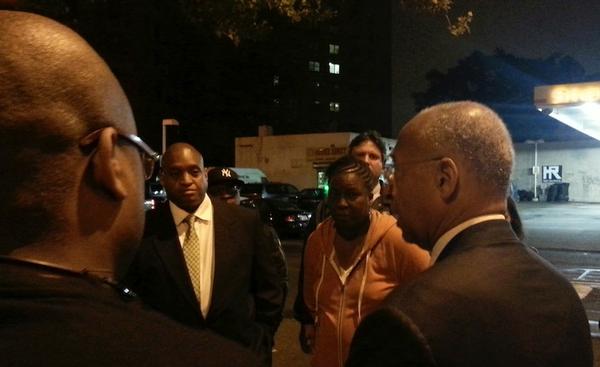
Photo by: Jarrett Murphy
Digna Layne, in the orange sweatshirt, listens as Bill Thompson addresses a small crowd on a Brownsville street corner early on Primary Day.
When a reporter waiting for Bill Thompson to arrive at a Brownsville street corner at 2:15 this morning walked across the street to a gas station to get a soda, then walked back, a few of the men who’d gathered to see the candidate laughed at his naivete. “You’re a brave man,” one cackled in mock admiration.
With several police officers on hand, the junction of Sutter Avenue and Mother Gaston Boulevard didn’t feel especially dangerous on a cool, quiet night. And as Digna Layne, a resident of NYCHA’s Brownsville Houses and the only person on hand who described herself as a local resident, interrupted to point out, trying to scare folks about the neighborhood is something of a disservice to the “decent people” in Brownsville.
But violence is certainly real here. The shooting death of one-year-old Antiq Hennis, hit while being pushed in his stroller in a killing that made headlines, occurred mere blocks away.
Asked why she’d come out to the event, one of the last stops on Thompson’s 24-hour pre-primary tour of the city, Layne said, “If there’s something happening in my community that’s a threat to my community, I’ll be out here.”
The top concern for people City Limits interviewed in Brownsville from February through the summer is public safety. Some people have qualms about stop-and-frisk and some don’t, but everyone is worried about crime, and particularly about the lack of guidance and meaning in the lives of young people who commit it.
Thompson’s message—and that of the people in his entourage—was tailor-made for those concerns. The National Action Network’s Tony Herbert, who has endorsed the former comptroller (NAN itself is neutral in the primary) said the Sutter-Gaston corner is a place where, for six weeks this summer, he and other activists “occupied” space through the night to deter violence. “When we were here this place was lit up with young people. Girls, 14, 15 years old. It was something to see,” he said. “You had to ask yourself, where are the parents?” Herbert praised Thompson for planning to devote city resources to providing more guidance to young people. Then he called the group to form a circle and pray.
“We ask that the gang-bangers will understand the origin of gangs,” prayed Pastor Michael Turner-Lewis from Bedford-Stuyvesant’s Rapha Evangelistic Worship Church. “It was to protect the community, not to menace society.” His colleague, Pastor Jamel Lewis, prayed that the city would come up with “ideas that will keep our children occupied” and “that will resurrect our community, resurrect our spirits and our hope, repair our shattered dreams.”
Many Brownsville residents say that beefs between extremely localized gangs have created a web of boundaries that local youth cross at their peril. “A kid who lives here,” Herbert said, motioning toward the Van Dyke housing development across the street, “can’t go in that direction. He has to go around, to avoid getting shot.”
When you have to fear for your life if you’re on the wrong side of the street, Thompson said, “you’ve reached the point of total insanity.”
As young men milled about a few dozen yards away, Thompson said people in neighborhoods like Brownsville were “being held hostage.” His plan to deal with it isn’t just about law enforcement, but also job training and social services. “When they lose hope, they believe they don’t have value, and then they believe others don’t have value,” Thompson said in his diagnosis of the violence, “and that’s why you see people shooting each other.”








